eLearning
A range of eLearning resources designed to help students develop critical knowledge and understanding of clincal pharmacology. These eLearning resources are a valuable interactive teaching aid, developed by national experts and integrated with the Prescribing Skills Assessment platform in order to support students’ practical prescribing skills.
- Developed by experts and quality checked through peer review
- Designed to work alongside a classroom environment
- Accessible anytime, anywhere through our online platform
- Students can revisit topics on demand and continually test their knowledge
- ‘Check your knowledge’ quizzes provide instant feedback and progression tracking
- Every student can be granted access to the full range of available topics or restricted as appropriate

The eLearning Course Structure
Designed to support learning for the Prescribing Skills Assessment, our eLearning resources are split into two key sections: Prescribing Skills and Clinical Pharmacology. Within these sections, each module includes a number of targeted 30-minute eLearning sessions. Each session is a complete resource, focused on a single content area with its own set of learning outcomes and prerequisites. Session content is a combination of written materials and interactive questions providing immediate feedback, allowing for students to gain a thorough understanding of each topic area.
Communicating Prescribing Decisions with Patients and Professional Colleagues
Calculating Drug Doses
Administration of Drugs by Subcutaneous Injection
Administration of Drugs by Intramuscular Injection
Administration of Drugs by Intravenous Injection
Administration of Drugs by Intravenous Infusion Pumps
Administration of Drugs Using Inhalers
Administration of Drugs Using a Nebuliser
Administration of Drugs to the Eye
Administration of Drugs to the Ear
Administration of Drugs to the Skin
Taking a Medication History
Finding Information About Adverse Drug Reactions
Finding Reliable Sources of Drug Information
How to use TOXBASE®
How to use the British National Formulary
Writing Prescriptions on a Hospital Drug Administration Chart
Writing prescriptions at discharge from hospital
Prescribing Oxygen
Initiating Anticoagulant Therapy with Warfarin and Heparin
Prescribing Insulin
Prescribing Intravenous Fluids
Intravenous Use Of Insulin And Diabetic Emergencies
Writing Prescriptions in General Practice
Maintaining Anticoagulation With Warfarin
Reporting Adverse Drug Reactions
Reviewing Hospital Prescription Charts
Pharmacodynamics I – Mechanisms of drug action
Pharmacodynamics II – Dose-response relationships
Pharmacodynamics III – Efficacy, potency and selectivity
Pharmacodynamics IV – Desensitisation and tolerance
Pharmacokinetics I – Introduction to pharmacokinetics
Pharmacokinetics II – Drug absorption
Pharmacokinetics III – Drug distribution
Pharmacokinetics IV – Drug metabolism and excretion
Pharmacokinetics V – Concentration-time relationships
Pharmacokinetics VI – Repeated drug dosing
Introduction to Clinical Pharmacology & Therapeutics
Drugs in healthcare and society
Individual variability in the response to drugs – Overview
Individual variability in the response to drugs – Pharmacogenetics
Adherence to medication
Concordance – partnership with patients
Monitoring drug therapy – using drug effect
Monitoring drug therapy – using drug concentration
Adverse Drug Reactions I – Basic principles
Adverse Drug Reactions II – Categorisation
Adverse drug reactions III – drug allergy
Drug Interactions – Overview
Drug interactions – liver metabolism
Medication errors – frequency and causes
Medication errors – prevention
Selecting drug dosage
Our eLearning Course In Detail
Modules within this section focus on drug administration. Students will learn about prescribing specific drugs and utilising resources related to prescribing. This content is ideal for undergraduate students in medically related degrees such as medicine, nursing and pharmacy. There are 27 sessions in total within the Prescribing Skills section with each session taking around 30 minutes to complete.
Modules within this section focus on the clinical aspects of pharmacology, including pharmacokinetics and pharmacodynamics, medication errors and adverse drug reactions. This content is ideal for undergraduate students in medically related degrees such as medicine, nursing and pharmacy. There are 26 sessions in total within the CPT section with each session taking around 30 minutes to complete.
As well as being hosted on the same online platform as the Prescribing Skills Assessment (which means students can see all their content in one place, with one login), our eLearning sessions have been designed to develop the knowledge and skills needed to succeed in the Prescribing Skills Assessment. They are the ideal preparation for candidates taking the Prescribing Skills Assessment.
Yes, these sessions have been written by UK experts with the aim to deepen candidates’ understanding of prescribing practices before they enter the clinical environment. They can be used alongside conventional preparation for the UK PSA and international PSA to reaffirm the essential knowledge needed to succeed in the exam.
Yes. Get in touch with the BPS Assessment team to discuss purchase and pricing options for your institution.


